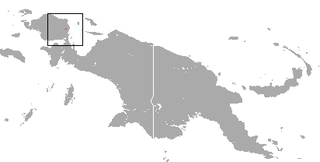 W
WThe Arfak pygmy bandicoot is a species of marsupial in the family Peramelidae. It is endemic to the Arfak mountains in the Vogelkop Peninsula of West Papua, in Indonesia. Its natural habitat is subtropical or tropical moist montane forests. The population is unknown and threats may be human expansion and hunting but it is protected by Arfak Reserve.
 W
WBandicoots are a group of more than 20 species of small to medium-sized, terrestrial marsupial omnivores in the order Peramelemorphia. They are endemic to the Australia–New Guinea region, including the Bismarck Archipelago and, marginally, in Indonesia (Seram).
 W
WThe Biak glider is a species of marsupial in the family Petauridae. It is endemic to the Schouten Islands in the western region of Papua Province, Indonesia. It was formerly considered to be a subspecies of Petaurus breviceps.
 W
WClara's echymipera, or Clara's spiny bandicoot or white-lipped bandicoot, is a species of marsupial in the family Peramelidae. It is found in West Papua, Indonesia and Papua New Guinea. Its natural habitat is subtropical or tropical dry forests. It is threatened by habitat loss.
 W
WThe common echymipera, or common spiny bandicoot, is a bandicoot. It is long-snouted even by bandicoot standards. The upper parts are a coarse reddish brown, flecked with spiny buff and black hairs. The tail is short and almost hairless. Length varies between 300 and 400 mm, with the tail accounting for an additional 80 to 100 mm; weight is from 600 to 2000 g.
 W
WDavid's echymipera, or David's spiny bandicoot, is a species of marsupial in the family Peramelidae. It is found on the island of Kiriwina, in the Trobriand Islands of Papua New Guinea, and may be present on other nearby islands also.
 W
WThe dingiso, also known as bondegezou, is a species of tree-kangaroo endemic to Papua Province central on New Guinea island, in northeastern Indonesia.
 W
WThe giant bandicoot is a species of marsupial in the family Peramelidae endemic to Papua New Guinea. Its natural habitat is subtropical or tropical dry forests.
 W
WThe great-tailed triok is a species of marsupial in the family Petauridae. It is found in West Papua, Indonesia and Papua New Guinea. Its natural habitat is subtropical or tropical dry forests.
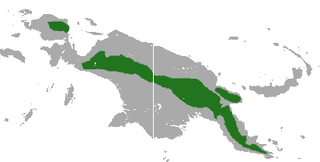 W
WThe long-fingered triok is a species of marsupial in the family Petauridae. It is found in West Papua, Indonesia and Papua New Guinea.
 W
WThe long-nosed echymipera, or long-nosed spiny bandicoot, is a species of marsupial in the family Peramelidae. It is found in Australia, Indonesia, and Papua New Guinea. Its natural habitat is subtropical or tropical dry forests.
 W
WThe mouse bandicoot is a species of marsupial in the family Peramelidae. It is endemic to West Papua, Indonesia. Its natural habitat is subtropical or tropical dry forests.
 W
WThe New Guinean mouse bandicoots or striped bandicoots are members of the order Peramelemorphia. In addition to the named species, there are two currently undescribed members of this genus.
 W
WThe northern brown bandicoot, a marsupial species, is a bandicoot found only on the northern and eastern coasts of Australia and nearby islands, mainly Papua New Guinea. It is not, however, found far inland.
 W
WThe northern glider is a species of marsupial in the family Petauridae. It is endemic to Papua New Guinea, becoming known to science in 1981 after being discovered in the Torricelli Mountains. This species has been found in primary, mid-montane tropical moist forests. It is also known from rural gardens close to forest. The northern glider is Critically Endangered because its occurrence is less than 100 km2, all individuals are located within a single area, and a continuing decline of its habitat quality due to deforestation and human encroachment. They also face a major threat from hunting.
 W
WThe Papuan bandicoot is a species of marsupial in the family Peramelidae. It is endemic to Papua New Guinea. Its natural habitat is subtropical or tropical dry forests. M. papuensis is a small bandicoot with a soft coat with a clear back, upper torso and face stripes. Its head to body length is 175–205 mm; tail length 142–158 mm; the hind foot length is from 43 to 47.1 mm; the ear length 25 to 28 mm and it weighs 145-184 g.
 W
WThe genus Petaurus contains flying phalangers or wrist-winged gliders, a group of arboreal marsupials. There are six species, sugar glider, squirrel glider, mahogany glider, northern glider, yellow-bellied glider and Biak glider, and are native to Australia or New Guinea.
 W
WRaffray's bandicoot is a species of marsupial in the family Peroryctidae. It is found in Indonesia and Papua New Guinea. Its natural habitat is subtropical or tropical dry forests.
 W
WThe red-legged pademelon is a species of small macropod found on the northeastern coast of Australia and in New Guinea. In Australia it has a scattered distribution from the tip of Cape York Peninsula in Queensland to around Tamworth in New South Wales. In New Guinea it is found in south central lowlands.
 W
WThe Seram bandicoot, also known as the Seram Island long-nosed bandicoot, is a member of the order Peramelemorphia that is endemic to the island of Seram in Indonesia. It is the only species in the genus Rhynchomeles.
 W
WThe striped bandicoot is a species of marsupial in the family Peramelidae. It is found in West Papua, Indonesia and Papua New Guinea. Its natural habitat is subtropical or tropical dry forests. The Striped bandicoot is a host of the Acanthocephalan intestinal parasite Australiformis semoni.
 W
WThe striped possum or common striped possum is a member of the marsupial family Petauridae. The species is black with three white stripes running head to tail, and its head has white stripes that form a 'Y' shape. It is closely related to the sugar glider, and is similar in appearance.
 W
WThe sugar glider is a small, omnivorous, arboreal, and nocturnal gliding possum belonging to the marsupial infraclass. The common name refers to its predilection for sugary foods such as sap and nectar and its ability to glide through the air, much like a flying squirrel. They have very similar habits and appearance to the flying squirrel, despite not being closely related—an example of convergent evolution. The scientific name, Petaurus breviceps, translates from Latin as "short-headed rope-dancer", a reference to their canopy acrobatics.
 W
WThe Tasmanian devil is a carnivorous marsupial of the family Dasyuridae. It was once native to mainland Australia and was only found in the wild on the island state of Tasmania. It has now been reintroduced to New South Wales with a small breeding population. The size of a small dog, the Tasmanian devil became the largest carnivorous marsupial in the world, following the extinction of the thylacine in 1936. It is related to quolls, and distantly related to the thylacine. It is characterised by its stocky and muscular build, black fur, pungent odour, extremely loud and disturbing screech, keen sense of smell, and ferocity when feeding. The Tasmanian devil's large head and neck allow it to generate among the strongest bites per unit body mass of any extant predatory land mammal. It hunts prey and scavenges carrion, as well as eating household products if humans are living nearby.
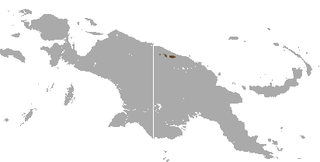 W
WThe tenkile, also known as Scott's tree-kangaroo, is a species of tree-kangaroo in the family Macropodidae. It is endemic to a very small area of the Torricelli Mountains of Papua New Guinea. Its natural habitat is subtropical or tropical dry forests. It is threatened by habitat loss and by hunting. The tenkile is listed as endangered due to hunting and logging activities in Papua New Guinea. The tenkile is hunted for its meat, and is the main protein source for the residents of Papua New Guinea. The population of Papua New Guinea has increased in recent years due to improvements in healthcare; therefore increasing need in tenkile meat which means that more tenkiles are being hunted. Additionally, tenkiles are poached for their fur and are captured and sold as a part of the illegal pet trade. Domesticated dogs also hunt tenkiles. Deforestation in Papua New Guinea affects all tree-Kangaroos, however industrial logging that occurs in the Torricelli Mountain Range decreases the species' already restricted habitat. The Torricelli Mountain Range faces additional deforestation due to the timber industry, and the production of coffee, rice and wheat.
 W
WTree-kangaroos are marsupials of the genus Dendrolagus, adapted for arboreal locomotion. They inhabit the tropical rainforests of New Guinea and far northeastern Queensland, along with some of the islands in the region. Most tree-kangaroos are considered threatened due to hunting and habitat destruction. They are the only true arboreal macropods.
 W
WDoria's tree-kangaroo is a tree-kangaroo endemic to Papua New Guinea.
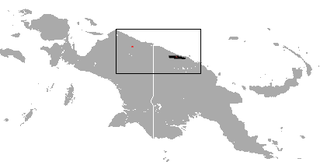 W
WThe golden-mantled tree-kangaroo is a species of tree-kangaroo endemic to the Northern New Guinea montane rain forests ecoregion of northern New Guinea island.
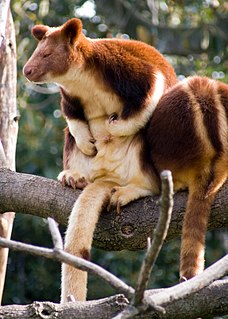 W
WGoodfellow's tree-kangaroo also called the ornate tree-kangaroo, belongs to the family Macropodidae, which includes kangaroos, wallabies and their relatives, and the genus Dendrolagus, with eleven other species. The species is native to the rainforests of New Guinea, and the border of central Irian Jaya in Indonesia. Under the IUCN classification, the species is listed as Endangered, which is a result of overhunting and human encroachment on their habitat. It is named after British zoological collector Walter Goodfellow.
 W
WThe grizzled tree-kangaroo is a small arboreal species of marsupial in the family Macropodidae. It is found in foothill forests of northern and western New Guinea and is indigenous to some of the offshore islands.
 W
WThe lowlands tree-kangaroo or lowland tree-kangaroo is a species of tree-kangaroo in the family Macropodidae.
 W
WMatschie's tree-kangaroo, also known as the Huon tree-kangaroo is a tree-kangaroo native to the Huon Peninsula of northeastern New Guinea island, within the nation of Papua New Guinea.
 W
WThe ursine tree-kangaroo is a species of marsupial in the family Macropodidae. It is endemic to the Vogelkop and possibly the Fakfak Peninsulas, West Papua, Indonesia. Other common names for this species include the black tree-kangaroo, the Vogelkop tree-kangaroo and the white-throated tree-kangaroo. It is threatened by habitat destruction and is listed as "vulnerable" by the International Union for Conservation of Nature.
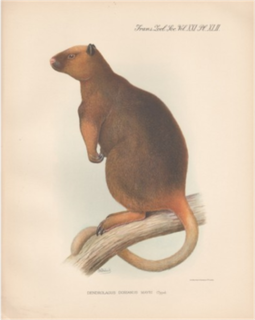 W
WThe Wondiwoi tree-kangaroo is a mammal species in the genus Dendrolagus. It was known until recently from a single specimen which was collected in 1928. The only known specimen is a male weighing 9.25 kilograms (20.4 lb). D. mayri was located in the Wondiwoi Peninsula of West Papua at an elevation of 1,600 metres (5,200 ft) within montane forest. It is thought that the Wondiwoi tree-kangaroo could occupy an area of 300 square kilometres (120 sq mi). Global Wildlife Conservation, the wildlife conservation charity, lists the Wondiwoi Tree Kangaroo as one of their "25 Most Wanted Lost Species".